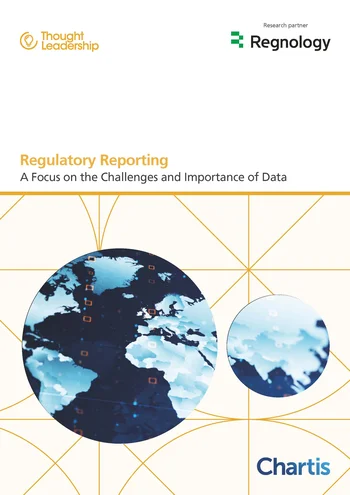Regulators
Complacent RiskTech vendors are sleepwalking into a new, deregulated reality
Tectonic regulatory and legislative upheaval promises to transform financial institutions’ RiskTech spending. As compliance-based revenue streams slow due to deregulation, solution vendors will need to adopt more business risk-focused strategies for their product lines. Chartis Chief Researcher Sid Dash considers the likely impact of growing deregulation, and how vendors can prepare.
Chartis Research Report Agenda, 2025
This document contains our full 2025 report agenda and timelines.
Regulatory reporting: deployment options and managed services
A collaborative article by Chartis and Regnology.
RiskTech100 2025 Winner’s Spotlight: Regnology
Regnology has secured the award for Regulatory Reporting in Banking, earned top honors in Supervisory Technology and ranked 22nd overall.
ClimateRisk50 2024
Chartis' inaugural ClimateRisk50 ranking and report recognizes the major players in climate risk analytical technology, providing a valuable assessment and benchmarking tool for market participants.
A New Regime: The Future of Private Credit and Risk Management Needs
A collaborative article by Chartis and RiskSpan.
Regulatory reporting: the transition from in-house to third-party systems
A collaborative article by Chartis and Regnology.
Regulatory Reporting Solutions, 2024: Quadrant Update
This report updates our previous research into the vendor landscape for regulatory reporting solutions, and provides an overview of our latest findings.
Regulatory Reporting Solutions, 2024: Market Update
This report updates our previous research into the market landscape for regulatory reporting solutions, and provides an overview of our latest findings.
Regulatory Reporting: A Focus on the Challenges and Importance of Data
This is the second in a series of Point of View articles exploring the evolution of regulatory reporting technology and the context in which it is transforming.
Vendor Analysis - Wolters Kluwer (CCH® Tagetik): IFRS 17 and LDTI Solutions, 2022
This Vendor Analysis summarizes the key theses in Chartis' IFRS 17/LDTI quadrant report, and takes a detailed look at Wolters Kluwer's quadrant positioning and scoring, and Chartis’ underlying opinion and analysis.
Regulatory Reporting Solutions, 2022: Market and Vendor Landscape
This report outlines Chartis’ view of the market and vendor landscape for regulatory reporting solutions that apply to banks and financial and capital markets. Contains one RiskTech Quadrant.
Beyond IFRS 17/LDTI: the Journey to System Modernization
This report, a collaboration between Chartis and FIS, examines the impact of IFRS 17 and LDTI on the insurance industry, giving an overview of the changes observed in the market, the industry’s evolving response, and how firms should prepare for the…
The Heart of IFRS 17 Compliance
This report examines the trends and dynamics around IFRS 17 compliance, examining why long-term success for insurance firms requires a heterogeneous, flexible and scalable data-management framework.
Vendor Analysis: Oracle Financial Services - Insurance Risk Systems for IFRS 17 and LDTI Compliance, 2020
This Vendor Analysis is based on the Chartis quadrant report 'Insurance Risk Systems for IFRS 17 and LDTI Compliance, 2020: Market Update and Vendor Landscape' (published in June 2020). This section summarizes the key theses in that report; subsequent…
Achieving Effective IFRS 17 Reporting
In this report, created in collaboration with Workiva, we focus on the challenges associated with IFRS 17 reporting, and consider solutions to those challenges from the perspectives of accounting policy and technology implementation. And in highlighting…






















